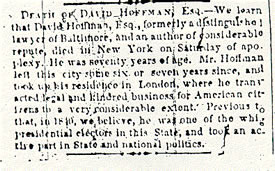
David Hoffman and the Science of Jurisprudence
Hoffman's Lasting Influence
 Death of David Hoffman, Esq. - We learn that David Hoffman, Esq.,
formerly a distinguished lawyer of Baltimore, and an author of considerable
repute, died in New York on Saturday. He was seventy years of age. Mr.
Hoffman left this city some six or seven years since, and took up his
residence in London, where he transacted legal and kindred business for
American citizens to a very considerable extent. Previous to that, in
1840, we believe, he was one of the Whig presidential electors in this
State, and took an active part in State and national politics.The
Sun, vol. 35, no. 154, Nov. 13, 1854. p.2, col.1
Death of David Hoffman, Esq. - We learn that David Hoffman, Esq.,
formerly a distinguished lawyer of Baltimore, and an author of considerable
repute, died in New York on Saturday. He was seventy years of age. Mr.
Hoffman left this city some six or seven years since, and took up his
residence in London, where he transacted legal and kindred business for
American citizens to a very considerable extent. Previous to that, in
1840, we believe, he was one of the Whig presidential electors in this
State, and took an active part in State and national politics.The
Sun, vol. 35, no. 154, Nov. 13, 1854. p.2, col.1
David Hoffman's Lasting Influence
By Bill Sleeman
When David Hoffman died in 1854 he had long been isolated from the American legal community. Although his 1817 outline continued to serve as a guide(1) for scholars, the law itself had experienced a fundamental change by mid-century.(2) No longer was the law the philosophical domain of classically trained scholars. Instead, it had become a craft performed by competent, narrowly trained practitioners.(3) That Hoffman was either unaware of this shift or unwilling to endorse it is reflected in his decision to extend his Course of Legal Study in 1836 and to publish his Legal Hints, a manual on deportment, in 1846. Hoffman's belief that the needs of practicing attorneys would best be answered by broad philosophical works that could assist them in their future education and scholarship was at odds with the growing demand for "practical" publications that by the 1850s represented the bulk of legal publishing in America(4).
Still, to think that because David Hoffman did not keep pace with the changes in the law meant that his theories on teaching law were a failure would be to judge his ideas too strictly. On the occasion of the first publication of his theory Justice Joseph Story wrote in the National Review that Hoffman's work was "an honor to the country"(5)that should be immediately implemented. Hoffman's method of study was soon adopted (or, in some instances adapted) by several of his peers at other institutions around the country. For example, there are echoes of the Outline in the early curriculum designs of both Benjamin Butler's program at New York University(6)and in the early efforts of Harvard University.(7) Hoffman's method for training lawyers even served, in an age before bar exams, as the model for evaluating the quality of would be attorneys in states as far away as Louisiana.(8) That Hoffman's influence reaches us even today can be seen in the more recent claims for him as the "father of American legal ethics."(9) Finally, the nature of contemporary legal study, which in many ways mirrors Hoffman's original interdisciplinary outline, suggests that his "science of jurisprudence" has remained a valuable method of training lawyers to combine the traits ofbothscholars andpractitioners:
Courses exploring the relationship between law and other disciplines reflect the faculty's view of the importance of a good lawyer's perspective on the law. Among these disciplines are the humanities, social science, health care policy, environmental policy, economic development and others.(10)
Notes
1. Robert A. Ferguson, Law and Letters in American Culture (Cambridge, MA: Harvard University Press, 1984) at 29. (return to text)
2. This change makes up the bulk of Part III in Ferguson's work and is central to Morton Horowitz' theory in The Transformation of American Law, 1780 - 1860 (Cambridge, MA: Harvard University Press, 1977).
4. Examples of publications representing the antithesis of Hoffman's ideals include John Collyer's A Practical Treatise on the Law of Partnership(1848); Isaac Redfield's A Practical Treatise Upon the Law of Railways(1858); David Graham's A Treatise on the Law of New Trials in Cases Civil and Criminal(1855); and Isaac Edwards' A Treatise on Bills of Exchange and Promissory Notes (1857).
5. This statement regarding Hoffman's work appears in most biographies about him, including both the excerpt from Cordell's History of the University of Maryland and the essay reprinted from the Dictionary of American Biography. The original citation is given as The North American Review, 1817 at 76. (return to text)
6. See Ronald L. Brown, The Law School Papers of Benjamin F. Butler, New York University School of Law in the 1830s (New York: Greenwood Press, 1987) for a discussion of both similarities and departures from Hoffman's ideals.
7. See Thomas L. Shaffer, David Hoffman's Law School Lectures, 1822-1833, 32 J. Leg. Ed. 127, 130 (1982).
8. Warren M. Billings, "A Course of Studies": Books That Shaped Louisiana Law. (unpublished manuscript - made available through the courtesy of Professor Billings).
10. The University of Maryland School of Law, Maryland Law, Embracing the Real World - 1997 Admissions Information Brochure at 5. (return to text)
